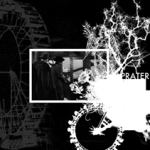electropoetics
Constructing the Other Half of The Policeman’s Beard

Leah Henrickson explores the contexts surrounding the publication of The Policeman's Beard is Half Constructed, advertised as “the first book ever written by a computer” at the time of its release in 1984. Drawing from contemporary reviews, personal correspondence with the book’s creators, and analysis of the book itself, Henrickson offers insight into precisely how this book was produced, and by whom. Although a computer program called Racter is listed as the author of The Policeman’s Beard, this attribution does not accurately reflect the human labor driving the book’s development and dissemination. This essay illuminates these networks of human labour that ultimately led to Racter and The Policeman's Beard.
Post-Digital Debates and Dialogues from the electronic book review

The lively dialogue among the contributing authors, ebr’s longest-serving and newly appointed editors, and the engaged and interested audience, which accompanied the Post-Digital / Dialogues and Debates book launch in September 2020, is an interesting insight into the recent debates on the multifaceted ramifications of digital disruption and the ways in which it has transformed our society, culture, and aesthetics. The discussion throws some light as well on the always fascinating history of the early electronic literature initiatives which had laid the groundwork for what eventually turned out to become the whole new field of intermedia literary practice and the sub-discipline of trans- and interdisciplinary academic inquiry. The authors of the mammoth 2-volume anthology recruit from the variety of contexts and offer diverse looks at the post-digital condition of our contemporaneity.
Reconfiguring Flatness on Screen: A Short History of Cover Designs for Chinese Web Novels

Renren Yang insightfully reveals the rarely (if ever) explored domain of cover designs for Chinese Web novels. Tracing their evolution from a print format that enables the tactile and sensual pleasures of opening the actual book to its supposedly more immaterial digital incarnation, Yang reimagines the very idea of a book cover in the digital age. This closer look reveals how serialized novels’ cover design frames the reader's experience, demonstrating as well the fact that the already well established periodization of the First, Second, and Third Generation e-literature are culturally and geographically specific, and dependent on the local histories of computing technology beyond Euro-American context. Analyzing the conceptual tension and fusion between book cover as a “mixed medium” and digital cover as “intermedium,” and drawing upon Chinese pictorial tradition, Yang defines the ontology of the digital book cover as an attempt at reconfiguring “flatness” on the digital screen.
“looked at me like I was wild s”: The Mediation of Settler-Colonial Visuality in Jordan Abel’s Injun

Alois Sieben investigates how Jordan Abel’s Injun experiments—poetically, visually, digitally—with an anxiety-provoking limit to the settler-colonial gaze, rather than feeding this gaze a new representation of Indigeneity. Abel’s work is positioned within David Garneau’s history of Indigenous screen objects, in which something is held back from the settler-colonial gaze, a form of deprivation that exposes the blind hunger of this gaze, turning it back upon itself.
The Visual Music Imaginary of 88 Constellations for Wittgenstein: Exploring Philosophical Concepts through Digital Rhetoric

88 Constellations for Wittgenstein (To be Played with the Left Hand) (2008) by Canadian artist David Clark is a web-based Flash creation that explores the life and works of Austrian-born philosopher Ludwig Wittgenstein. In this paper, we show how rhetoric and digital technologies join to visually express philosophical concepts. The idea of “visual music” has been previously addressed in various fine arts such as literature, film, painting, sculpture, and music itself. We argue that in electronic literature it is possible to explore this concept by means of what we propose to call “gestural melodic manipulation”, which is the interplay of semiotic units (e.g. videos, sounds, images, linguistic texts) that the reader can add to the narrative by means of interaction and manipulation. In Clark’s e-lit work, “visual music” triggers the literary characteristics of the text by exposing different discourses and diverse thematic through intertextual and intermedial practices.